http://nashvilledominican.org/charism/st_dominic/nine_ways_of_prayer

1. Bowing Deeply
He taught the brethren to do this whenever they passed before a crucifix showing the humiliation of Christ, so that Christ, who was humbled for our sake, might particularly see us humbled before his greatness. Similarly he told the brethren to humble themselves like this before the whole Trinity when¬ever ‘Glory be to the Father and to the Son and to the Holy Spirit’ was recited solemnly.
This way of prayer was the beginning of his devotion: bowing deeply.

2. Falling Prostrate
Sometimes, wanting to teach the brethren with what reve¬rence they ought to pray, he would say to them, ‘The Magi, those devout kings, entered the house and found the child with Mary, his mother (Matthew 2:11). Now it is certain that we have found him too. God and man, with Mary his handmaid, so come, let us fall down and worship before God, let us weep before the Lord who made us’ (Psalms 94:6).
He exhorted the young men too, saying to them, ‘If you cannot weep for your own sins, because you have none, still there are many sinners to be directed towards mercy and love, for whose sake the prophets and apostles groaned in distress, and for their sake too Jesus wept bitterly when he saw them (Luke 19:41), and similarly the holy David wept and said, “I saw the half-hearted and I pined away”’ (Psalms 118:158).

3. Penance
For this reason, rising up from the ground, he used to take the discipline with an iron chain saying, ‘Your discipline has set me straight towards my goal’ (Psalms 17:36). This is why the whole order determined that all the brethren, out of respect for the memory of St. Dominic’s example, should take the discipline on their bare backs with sticks of wood every ferial day after Compline, saying the Miserere or the De profundis. They were to do this either for their own sins or for those of others whose gifts support them. So no one, however innocent, should withdraw himself from following this holy example.

4. Genuflection
After this, St. Dominic, standing before the altar or in the chapter room, would fix his gaze on the crucifix, looking intently at Christ on the cross and kneeling down over and over again, a hundred times perhaps; sometimes he would even spend the whole time from after Compline until midnight getting up and kneeling down again, like the apostle James, and like the leper in the gospel who knelt down and said, ‘Lord, if you will you can make me clean’ (Mark 1:40), and like Stephen who knelt down and cried out with a loud voice, ‘Lord, do not hold this sin against them’ (Acts 7:59).
He was so accustomed to genuflecting that, when he was on a journey, whether in a hostel after the toils of the road or on the road itself, while the others were sleeping or resting, he would return to his genuflections as to his own special art and his own personal service. This way of prayer he taught more by the example of his practice than by what he said.
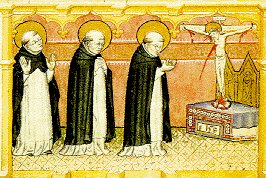
5. Contemplation
Sometimes, when he was in a priory, our holy father Dominic would stand upright before the altar, not leaning on anything or supported by anything, but with his whole body standing erect on his feet. Sometimes he would hold his hands out, open, before his breast, like an open book, and then he would stand with great reverence and devotion, as if he were reading in the presence of God.
At other times he joined his hands and held them tightly fastened together in front of his eyes, hunching himself up. At other times he raised his hands to his shoulders, in the manner of a priest saying Mass, as if he wanted to fix his ears more attentively on something that was being said to him by someone else.
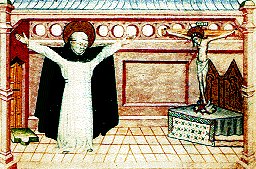
6. Earnest Intercession
Sometimes, as I was told personally by someone who had seen it, our holy father Dominic was also seen praying with his hands and arms spread out like a cross, stretching himself to the limit and standing as upright as he possibly could. This was how he prayed when God restored the boy Napoleon to life at his prayer at San Sisto in Rome, both in the sacristy and in the church during the Mass in which he rose from the ground, as we were told by that devout and holy sister, Cecilia, who was present with a great crowd of others and saw it all. Like Elijah when he raised the widow’s son, he stretched himself out over the boy’s body (1 Kings 17:21).
This was how the Lord prayed when he hung on the cross, his hands and arms stretched out, when, with great cries and weeping, his prayer was heard because of his reverence (Hebrews 5:7). The holy man of God, Dominic, did not use this kind of prayer regularly, but only when, by God’s inspiration, he knew that some great wonder was going to occur by virtue of his prayer. He neither forbade the brethren to pray like this nor did he encourage it.
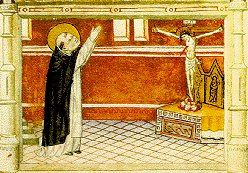
7. Supplication
He was also often found stretching his whole body up towards heaven in prayer, like a choice arrow shot straight up from a bow (Isaiah 49:2). He had his hands stretched right up above his head, joined together or slightly open as if to catch something from heaven. And it is believed that at such times he received an increase of grace and was caught up in rapture, and that his prayer won from God, for the order he had founded, the gifts of the Holy Spirit and, for himself and for his brethren, such delight and enjoyment in putting the Beatitudes into practice that each one would consider himself blessed in the most profound poverty, in bitter grief, in severe persecution, in great hunger and thirst for righteousness, in all the cares and worries of mercy (Matthew 5:3-10), and that they would all consider it a pleasure to observe the commandments with devotion and to follow the evangelical counsels. At such times the holy father seemed suddenly to enter the Holy of Holies and the third heaven (2 Corinthians 12:2). And so, after this kind of prayer, he bore himself like a prophet, as is related in his miracles, whether he was rebuking or dispensing or preaching. Just one example must be given here, briefly, for edification’s sake.
So the holy father did not remain long in this kind of prayer, but returned to himself as if he were coming from far away, and at such times he seemed to be a stranger in the world, as could easily be seen from his appearance and his behavior. While he was praying he was sometimes clearly heard by the brethren saying, as the prophet did, ‘Hear the voice of my supplication while I pray to you and while I lift up my hands to your holy temple’ (Psalms 27:2). And the holy master taught the brethren to pray like this, both by his words and by his example. He quoted from Psalm 133:2, ‘At night lift up your hands to the holy place,’ and Psalm 140:2, ‘The raising of my hands like an evening sacrifice.’
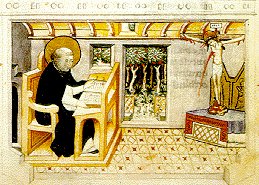
8. Thoughtful Reading
The holy father Dominic also had another beautiful way of praying, full of devotion and grace. After the canonical hours and the grace which is said in common after meals the father would go off quickly to some place where he could be alone, in a cell or somewhere. Sober and alert and anointed with a spirit of devotion which he had drawn from the words of God which had been sung in choir or during the meal, he would settle himself down to read or pray, recollecting himself in himself and fixing himself in the presence of God. Sitting there quietly, he would open some book before him, arming himself first with the sign of the cross, and then he would read. And he would be moved in his mind as delightfully as if he heard the Lord speaking to him. As the Psalm says, ‘I will hear what the Lord God is saying in me, because he will speak peace to his people and upon his saints, and to those who turn to him with all their heart’ (Psalms 84:9).
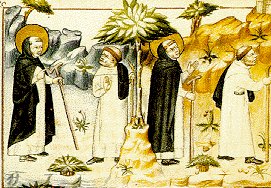
9. Praying on a Journey
He also used to observe this way of prayer when he was going from one country to another, especially when he was in a lonely place. He disported himself with his meditations in his contemplation. And sometimes he would say to his travelling companions, ‘It is written in Hosea, “I will lead her to a lonely place and speak to her heart”’ (Hosea 2:14). So sometimes he went aside from his companion or went on ahead or, more likely, lingered far behind; going on his own he would pray as he walked, and a fire was kindled in his meditation (Psalms 38:4).
A curious thing about this kind of prayer was that he seemed to be brushing away ashes or flies from his face, and because of this he often defended himself with the sign of the cross. The brethren thought that in this kind of prayer the saint acquired the fullness of sacred scripture and the very heart of the understanding of God’s words, and also a power and boldness to preach fervently and a hidden intimacy with the Holy Spirit to know hidden things.
In Summary:

http://nashvilledominican.org/charism/st_dominic/nine_ways_of_prayer
No comments:
Post a Comment